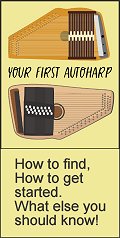
<

<

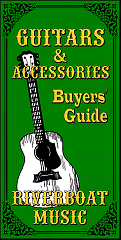
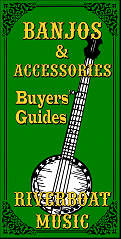
|
Autoharps for People With Short Arms
This page started out as a supplement to the Buyers' Guide for Autoharps on our RiverboatMusic.com page. We have now expanded it to supplement the Choosing Autoharps Overview page on our Harpers Guild page.
Our articles about choosing autoharp have brought in a lot of reader questions, most of which had answers. Here's one that doesn't, exactly, have a good answer. What if you want to play autoharp but you are prevented from playing one in upright position (the way most folks hold them today) by short arms, or nerve damage or something else that makes it impractical or painful?
Note About Availability: Although we also have an autoharp buyers' guide that has links to places you can buy recommended products, none of the instruments on this page are available from any vendor I have a financial relationship with. - The Oscar Schmidt and Chromaharp instruments listed here have not been made since the 1960s and are difficult to find in playable condition.
- Narrow, but top-quality custom autoharps like the Evo Bluestein 'Sparrowharp' shown further down must be custom-ordered from a luthier such as Pete D'aigle of d'Aigle Autoharps.
In other words, this page isn't selling you anything. We're simply showing you instruments that may give folks with short arms, or muscle or nerve issues, some idea of the things they might consider if the size, shape or weight of a full-sized autoharp is inconvenient or painful. We hope you find it helpful.
Now for some of the choices you might consider.
Consider Horizontal Position
 First of all, have you considered playing your autoharp laying on a table or in your lap, the way they used to be played? If you look at the most popular older Oscar Schmidt autoharps, frequently called "Model 73," you'll see that there is a lot of room between the chord bars and the bridge. The expectation was that you would lay the thing in front of you, push the buttons with your left hand, and strum or pick over the paper with the note names with your right. First of all, have you considered playing your autoharp laying on a table or in your lap, the way they used to be played? If you look at the most popular older Oscar Schmidt autoharps, frequently called "Model 73," you'll see that there is a lot of room between the chord bars and the bridge. The expectation was that you would lay the thing in front of you, push the buttons with your left hand, and strum or pick over the paper with the note names with your right.
Though the picture above shows a century-old 12-chord instrument, Oscar Schmidt did make 5 chord versions well into the 1960s, so you might find one that's not quite a museum piece to sell. Alternately, you could buy a modern instrument (probably a 15-chorder) and move the chord bars to give you more room on the 'south' end - don't laugh, autoharp players do stranger things to their instruments.
In fact, some autoharps have been built that must be played in a horizontal position. These include the briefcase-style Oscar Schmidt "Educator," which was built for elementary school music teachers and the massive Chromaharp "Caroler," which was built for small chuches and other groups that couldn't afford a piano but needed more chords than conventional autoharps offered. Neither have been made in the last thirty-five years, but they occasionally turn up on the used marketplaces.
Consider Over-the-Knee Position
Okay, call me stupid. I always thought the concave edge of autoharps was either ornamental, or, in later versions, to help you reach around with your left hand better.
It wasn't until I was investigating smaller harps that I realized that dip was made to go over your knee, the same way a guitar does. Your left hand would reach down across the chord bars instead of coming around the 'harp.
This is actually quite comfortable with smaller harps like the OS6, OS10 and early Zimmerman (shown below). Slightly less comfortable, but still possible with a full-sized Type A or type B OS Autoharp or contemporary Chromanarps.
Remember, the autoharp wasn't built to play "upright" like players do today. That changed when early Mountain-music inspired folks like the Carter Family started playing venues or recording in studios with a single microphone (almost all venues and studios in those days). Soloists moved in and out as their turn to "shine" came and went.
And the only way an autoharp player could do that was by holding the thing vertically. But you don't have to do it that way.
What About Obsolete and Hard-to-Find Instruments?
Over the years, Oscar Schmidt and Chromaharp made several instruments that could be played in an upright position by people with short arms. None of these are being manufactured today, and most of them are hard to find used in playable or reasonably restorable condition. But on the off chance that one turns up while you're looking for this sort of thing, we're posting what we have been able to can find out about them.
 OS 6 - EasyChord OS 6 - EasyChord
Oscar Schmidt's "itty bitty" 6-chord "Easychord" instruments were marketed for children in the early 1980s, but sometimes snapped up by adults who played them just for fun. They were available in several finishes, with natural and red being the most common.
Interestingly, the first year they were only a block of wood, after which they were made hollow like other OS autoharps. If you go shopping for one of these, make certain it has a hole in the face. The "block-of-wood" versions are great for practicing when someone in the room is sleeping, but ot for much else.
Chords are Bb, F, C7, C, D7, G, which should technically allow you to play three-chord songs in F, C, and G.
Since I first wrote this article, I've accumulated several that I use for my workshops. A few of them needed repair, but most of which were playable as soon as they were tuned.
 Chromaharp's "Miniharp" - Chromaharp made a similar instrument with only five chords (Bb, F, C7, C, and G), called a "Miniharp." Theoretically this would allow you to play three-chord songs in F and C. 19 strings. There would be room for several more chord bars if you don't mind building your own and maybe adapting the chord bar holders from a 10- or 12-chorder. Chromaharp's "Miniharp" - Chromaharp made a similar instrument with only five chords (Bb, F, C7, C, and G), called a "Miniharp." Theoretically this would allow you to play three-chord songs in F and C. 19 strings. There would be room for several more chord bars if you don't mind building your own and maybe adapting the chord bar holders from a 10- or 12-chorder.
The strings are longer than those on the EasyChord, and they have a good sound. That said, the EasyChord is more solid and has more chords, so that would be my preference.
 OS 10 Sierra OS 10 Sierra
For a time, OS produced the 10-chord Oscar Schmidt OS10, advertised as a 3/4-sized autoharp. It came in at least three colors, red, brown, and yellow-green (something like the color of Mountain Dew spilled on a white tablecloth). The model names include hints as to the color, such as (OS10RD, OS10BR, OS10PY, respectively).
These can play in more keys than many 'harps because they sacrificed the seventh chords to add more major chords. That said, they departed from the chord arrangements then available on most OS 'harps, and that made them less desirable to some folks.
This may be the first commercial OS autoharp before the relatively recent (and much larger) Americana to include Bm, making it relatively guitar-friendly (though not fiddle-friendly - you can't play in A or E). 30 strings.
Personally I think these would be decent starter 'harps for smaller people, if only more of them were available. Don't put off getting an autoharp until you can find one of these, though. In recent years, they've become almost impossible to find.
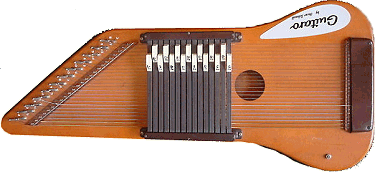 Oscar Schmidt Guitaro Oscar Schmidt Guitaro
Now for the "Keytar" of autoharps, the Oscar Schmidt "Guitaro." It's hard to say if more of these were made than the scaled-down autoharps above, but more seem to have survived. Perhaps beause they weren't marketed to children. They were released in the early-to-mid 1960s when the Folk Revival was in full swing, and guitar players were dominating the music scene. In theory, you hold it like a guitar and reach your left hand under and around the chord bars to push the buttons. They have more strumming area than all other models combined. Autoharp players are suspicious of them because of the location of the buttons - they don't look like they should force the whole cord bar down. But I'm told that the buttons has a scissor mechanism that applied equal pressure the length of the bar.
Two versions were made, the one shown and another one that had a resonator attached to the back. The mechanism was the same.
24 strings. The fifteen chords (in Circle-of-Fifths sequence) are Bb, F, C, C7, G, G7, Gm, D, D7, Dm, A7, Am, E7, Em, and B7, almost enough to play most Folk-based songs that were getting airplay. I believe it's the first Oscar Schmidt autoharp to include B7; needed for songs like "Walk Right In." That said, I would gladly trade, say, the Bb, C7 and G7 for, A, E, and Bm. There's room on the instrument for more chord bars, if you want. Though, truth be told, I doubt the thing would have been successful even if it was totally "Folk-friendly" - it's just too hokey-looking.
Today you see folks playing them in the 60-degree position and in lap position. You also see the chord bars moved down so the thing can be played in a more upright position.
Some folks have even put the 21-chord conversion kits on the things. Though with their 24-string structure they'll never have the sound of a 36 or 37-stringed autoharp, the longer songboard shouldn't exactly hurt the sound.
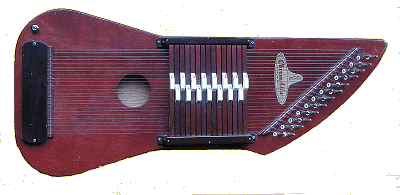 Chromaharp's Chromalin - Never one to be left in the dust, Chromaharp made their own version, called the Chromalin. It differs chiefly in having the buttons near the center of the chord bars, so reaching them while holding the device in a guitar position is more difficult, but it's easy to play in upright position. Chromaharp's Chromalin - Never one to be left in the dust, Chromaharp made their own version, called the Chromalin. It differs chiefly in having the buttons near the center of the chord bars, so reaching them while holding the device in a guitar position is more difficult, but it's easy to play in upright position.
The other "downside" to the Chromalin being used for its intended purpose (as a quasi-guitar for Folk groups) is that it kept the standard 15-chord setup, so it was less "Folk-friendly." It did have a solid spruce top, and some folks who've come across these in recent years have found them fun to play. That said, properly restored, it would be a dandy instrument for a short-armed person who wanted to hold an autoharp upright without dislocating their shoulder.
 Chromaharp even made an electric version called the "Electric Chroma II" (CAP 2525) with a shape that was apparently inspired by Fender Jaguar guitars and - get this - individually geared tuning pegs. 15 chords, 36 strings, and an electric pickup. It's ugly, but might have been practical, unless the tuning pegs sticking out the back interfered with your collarbone when you tried to hold it upright. Chromaharp even made an electric version called the "Electric Chroma II" (CAP 2525) with a shape that was apparently inspired by Fender Jaguar guitars and - get this - individually geared tuning pegs. 15 chords, 36 strings, and an electric pickup. It's ugly, but might have been practical, unless the tuning pegs sticking out the back interfered with your collarbone when you tried to hold it upright.
At the moment, it needs repair, so i can't complicate on its practicality, even if you can find one.
Five-Chord Autoharps were invented about 1885 and were built up to 1965. The early ones had a stained finish. The next generation was black with fancy decals, often including a decal that announced "The Favorite."

Both of the early versions were popular, dandy instruments in their time, but they may have problems due to age. Plus the chord bar labels used a bizarre numbering scheme that nobody uses today. It's not hard to figure out - there are only five chords, after all.
I have a few that are playable and fun. But due to possible bad storage, etc., don't spend "real money" on a very early model without getting your hands on it, unless the seller has a generous return policy.
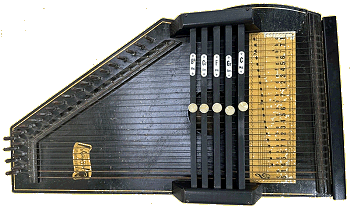 That said, if you can find a postwar 5-chorder in good condition, it can give you a nice start on learning autoharp. That said, if you can find a postwar 5-chorder in good condition, it can give you a nice start on learning autoharp.
Look for:
- A black, very shiny face
- MInimum rust on the strings and tuning pegs
- Chord bar labels that have only the names of the chords.
- A tailpiece that covers the part where the strings fasten.
- Preferably, the scroll style logo shown on the last example.
- The back should not be pulling away.
For more information about 5-chord autoharps, including playing tips, see our article "The Five-Chord Wonder."
Custom Autoharps
At least two custom autoharp builders are making professional-quality autoharps that are about as long as standard autoharps, so they have a pretty full tone, but they're narrower, so they're easier for people with short arms to play.
 Sparrowharp - The best-known in this class is the Evo Bluestein "Sparrowharp." Evo is an expert player and builder who designed a number of 'harps, of which this is the best known. Sparrowharp - The best-known in this class is the Evo Bluestein "Sparrowharp." Evo is an expert player and builder who designed a number of 'harps, of which this is the best known.
Our family owns one, and it's very nice. Friends who've purchased them also appreciate their sound and ease of playing.
At the moment, Sparrowharps are being made by Pete D'Aigle of D'Aigle Autoharps. If you contact them, please tell them we sent you.
 Heartland - Luthier Ken Ellis's Whipporwhill Acoustics produces several instruments, including the "Heartland," another autoharp that is narrower than standard. They have gotten great reviews from well-known autoharp players. Again, if you contact Ken, tell him we sent you. Heartland - Luthier Ken Ellis's Whipporwhill Acoustics produces several instruments, including the "Heartland," another autoharp that is narrower than standard. They have gotten great reviews from well-known autoharp players. Again, if you contact Ken, tell him we sent you.
Either autoharp above can be ordered with any chord bar arrangement you want, though at the moment the "Heartland" is typically a 15-chorder.
What about Building Your Own?
Okay, that may sound crazy, but folks have done just that. I'm told that The Autoharp Owner's Manual by Mary Lou Orthey tells you how to "roll your own," and I suspect you could scale one down to get one the size you need. Look at the Sparrow - it makes a 36-string 'harp narrow than a standard autoharp by putting the strings closer together. You could do that. Or maybe someone you know could do that.
Other than the new strings you'd certainly need, you could even get many of the parts by picking up a basket case and pulling out the pegs, etc.
Okay, I may be reaching, and such a project is certainly over my head. But folks have done it.
Conclusion
Again, I don't sell any of these, though I have owned examples of most of them. But I wanted to let you know that instruments like these have been made in the past, and who knows, one may turn up in playable or restorable condition for a price you can afford.
However you chose to acquire the instrument coming into your household, we wish you the best, and we'll answer your questions if we can.
In the meantime, please contact us with any questions at all - reader questions are the main thing that drivers our research, so we're always happy to hear from you.
Best of luck!
 Whatever else you get out of our pages, I hope you come away with some great ideas for "sharing the joy." Whatever else you get out of our pages, I hope you come away with some great ideas for "sharing the joy."
And please stay in touch!
- Paul Race







|  > > |

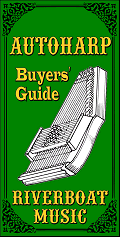














 Heartland - Luthier Ken Ellis's
Heartland - Luthier Ken Ellis's 




































